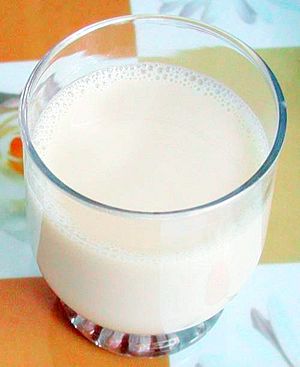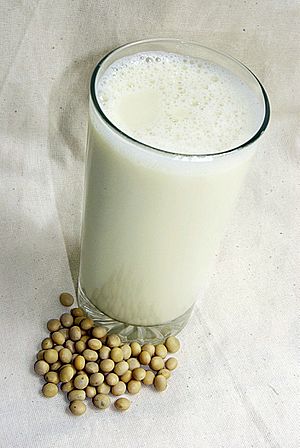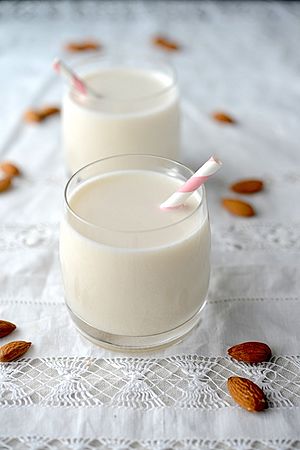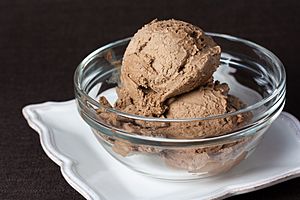Milk substitute facts for kids
A milk substitute is a drink that looks and tastes a lot like regular milk. These drinks are often made from plants. They can contain plant-based fats and proteins instead of those from animals.
Many people choose milk substitutes for different reasons. Some people have lactose intolerance, which means their bodies can't easily digest the sugar in milk. Others have a milk allergy. Also, people who follow a vegan diet, which means they don't eat any animal products, use milk substitutes.
The two main types of milk substitutes are grain milk and plant milk. Some popular examples include rice milk, soy milk, almond milk, and coconut milk.
Contents
Why Choose Milk Substitutes?
People choose milk substitutes for many reasons. Some want healthier drinks that taste like milk. They might also want the same nutrients found in cow's milk.
Milk substitutes are great for vegans. They also help people with lactose intolerance or allergies to dairy. This way, everyone can enjoy foods that usually have milk.
Popular Milk Alternatives
There are many different kinds of milk substitutes available today. Each one has its own special qualities.
Soy Milk
Soy milk is one of the most popular plant-based milks. It is made from soybeans. Soy milk has about the same amount of protein as dairy milk. Some brands add important nutrients like calcium, vitamin D, and B vitamins such as B12. Soy protein might also be helpful for kidney health.
Almond Milk
Almond milk is made by grinding almonds with water. Then, the solid parts are strained out. You can even make almond milk at home! It is usually low in fat and calories.
Rice Milk
Rice milk is made from rice. It has a sweet taste, so it's often used in baking. It's a good choice for people who are allergic to nuts or soy. When extra nutrients are added, rice milk can be a source of calcium and vitamins B12 and D2.
Hemp Milk
Hemp milk is made from hemp seeds. These seeds are ground with water and then strained. It has a nutty, creamy taste. Hemp milk is naturally rich in protein and important amino acids.
Coconut Milk
Coconut milk is made from the white inside part of a ripe coconut. Water is mixed with the grated coconut pulp. It contains calcium and several B vitamins. Coconut milk is often high in fat and calories. It's also low in protein. It can be used like cream to decorate desserts.
Milk from Yeast
Some new milk substitutes are made using yeast. In this process, sugar is mixed with yeast. This creates proteins that are just like the ones in cow's milk. These proteins are then mixed with plant-based sugars, fats, and minerals. The result is a milk that can be used like regular milk, even for making cheese. This method does not use animals. It also uses less land and produces fewer greenhouse gases.
Understanding Lactose Intolerance
Lactose is the main sugar found in milk. Lactose intolerance happens when a person's body doesn't make enough of an enzyme called lactase. This enzyme is needed to break down lactose in the stomach.
If someone with lactose intolerance drinks milk, they might feel bloated or have cramps. They could also have constipation or diarrhea. Luckily, there are many foods made with milk substitutes. This means people with lactose intolerance can still enjoy things like milk, yogurt, whipped topping, and ice cream.
How Lactose-Free Foods Are Made
Making foods without lactose can be a bit different. For example, regular ice cream uses milk products that contain lactose. But non-dairy ice cream can be made using vegetable oils like coconut oil or soybean oil. These oils are mixed with other ingredients like emulsifiers and sweeteners to create a similar texture and taste.
Many smaller companies make natural, non-dairy ice creams. They often use coconut milk or plant cream as a base. These ingredients help make the ice cream creamy and prevent ice crystals from forming.
Infant Formulas
Sometimes, Breast milk substitutes are needed for babies. These are called infant formulas. Formulas made from cow's milk can be used to add to breast milk or as a baby's only food source before they start eating solid foods.
It's very important that infant formulas have all the right nutrients for babies. They must be fortified with things like iron to help babies grow and stay healthy. For families who want to avoid animal products, there are soy-based or rice-based infant formulas available.
Images for kids
-
A range of packaged plant milks from a Western grocery store.
-
Coffee-Mate, a synthetic coffee whitener made for use in coffee








